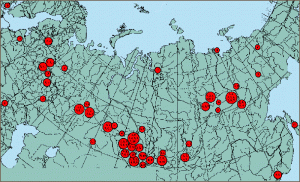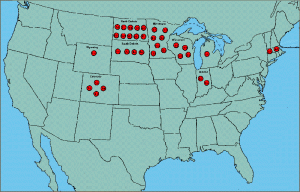Institute of Cytology and Genetics, SB RAS, Novosibirsk
Novosibirsk State University, Faculty of Natural Sciences,
Department of Cytology and Genetics
Head of the Institute:
Vladimir K.Shumny, Academician of the RAS
10 Lavrentiev Ave., Novosibirsk, 630090, Russia
Tel.: +(383-2) 33-35-26
Fax: +(383-2) 33-12-78, 33-34-66
Principal researchers:
I.I.Kiknadze, Prof.
N.A.Kolchanov, Prof.
A.S.Frolov, Dr.
V.V.Golygina, Dr.
Project objectives
The aim of this project is to develop the NPCV database ñ Natural populations and chromosomal variability in Chironomidae (Diptera, Chironomidae). The database will summarise the results of our 40 year research on chironomid cytotaxonomy, karyotype evolution and cytogenetic divergence of populations in different zoogeographic zones.
Chironomidae (midges) are one of the most prosperous family among Insecta in modern environment. Because of their great species richness and abundant occurrence in the most freshwater habitats, chironomids are of obvious interest to limnologists and ecologists. Larvae of chironomids has a worldwide distribution, they predominate in benthos communities and they are usually used as the best food for many fish species. Biomonitoring studies include chironomids as indicator organisms for water quality and waterbodies productivity. The concept of using chironomid taxa for lake classification suited for biomonitoring was developed. The presence of giant polytene chromosomes in cells of chironomid larvae allows one to record all chromosomal rearrangements induced by anthropogenic pollution factors (Thinemann, 1974, Sokolovae, 1983, Baluschkina, 1989, Kiknadze, 1991, 1996, Rosenberg and Resh,1993, Johnson, 1995).
The presence of giant polytene chromosomes in chironomid larvae also allows one to carry out detailed population analysis of chromosomal variability and to determine the whole spectrum of chromosomal rearrangement as a genetic basis for adaptation of populations. The results of such a cytogenetic analysis have not only provide significant applications for biomonitoring, but they are also very important for fundamental problems of microevolution. However, the population structure of chironomid species was not studied thoroughly up to now in spite of numerous studies on chironomid taxonomy and ecology.
Background and significance of objectives
The purposeful 40 year study of cytotaxonomy and cytogenetic structure of populations in chironomid species was carried out by authors. The sets and frequencies of chromosomal banding sequences, especially inversion sequences, were recorded in different populations all over their areas. Correspondingly, species karyofunds were determined, adaptive and evolutionary potential of species were evaluated. The cytogenetic distances between populations within species and between different species were calculated, dendrograms of cytogenetic divergence between populations and species were prepared. The relations between the number of chromosomal rearrangement steps and genetic distances (time to split) were analysed.
In total, karyofunds of 8 Holarctic, 50 Palearctic, and 11 Nearctic chironomid species were studied. The Holarctic species were actually the best model for studying the relationship between geographic variations of banding sequences and population divergence. These species are widely spread over two continents (Eurasia=Palearctic and North America=Nearctic), and they have been continentally isolated near 1.5-2 millions years. We have analysed in detail the karyofunds in 6 Holarctic species (Camptochironomus tentans ñ 40 populations, C.pallidivittatus ñ 30 populations, Chironomus plumosus ñ 60 populations, C. entis ñ 40 populations, C.annularius ñ 15 populations, Glyptotendipes barbipes ñ 30 populations). We were the first who evaluated the volumes of karyofunds in Holarctic species and revealed that they vary: from 29 to 44 inversion sequences per species.
Data on the set, number and frequencies of inversion sequences investigated reflect the state of karyofund of species at present and then these characteristics can be used as a standard to the following biomonitoring.
The NPCV database will include all information on species studied, geographic coordinates of populations, morphology of each species at different stages of development (larva, pupa, adults), karyotype structure, mapping of standard and inversion banding sequences, scanning photographs of all sequences in homo- and heterozygous states, frequencies of inversion sequences and their genotypic combinations.
This material will be available to each user interesting in morphology and karyotypes of Holarctic, Palearctic and Nearctic chironomid species, their distribution, level of chromosomal variability and chromosomal polymorphism in relation to geographic position of populations, seasons of year, type of waterbody etc.
The database allows one to systematise all information on the distribution of different genotypes and chromosomal variants in different ecosystems, to analyse the regularity of chromosomal polymorphism and its role in the adaptation of populations and specialisation to develop the chironomid cytophilogeny, to reveal the role of different inversions in karyotype divergence, to evaluate mono- or polyphelitic origin of chironomid species and their migrations.
Information on both species-specific inversion (characteristics of different kind of inversions with estimation of their ability to be fixed) and fluctuated inversions (inversions occurring only in heterozygous state) is very important.
Comparative investigations of localisation and frequencies of points of breaks along the length of chromosomal arms of different species will give the possibility to analyse regularities of chromosomal variability in connection with the chromosomal size, type of chromosome (meta-, submeta-, telocentric), position of heterochromatin etc.
Research plan: approaches and methods
The complex of the following methods was used to study cytogenetic structure of populations: 1) the associated morphological and karyological analysis of each larvae examined; 2) the modified method of acetorcein staining of polytene chromosome squashes (Kiknadze et al., 1991); 3) the estimation of frequencies of inversion banding sequences and its genotypic and zygotic combinations; 4) the estimation of cytogenetic distances between populations and species developed on Nei method (Nei, 1972, Gunderina et al., 1999); 5) the estimation of a type of cytogenetic structure of populations (Gunderina et al., 1999); 6) the study of genetic polymorphism in populations by enzyme polymorphism (Gunderina et al., 1989); 7) the differential staining of polytene chromosomes.
Expected results
The results expected will include first of all the database developed in which data on the analysis of the significance of the numerous variants of chromosomal banding sequences found between individuals, populations and species will be accumulated. It will be shown that geographic variation of banding sequences is actually a model of population divergence and species formation. Database can be used for biomonitoring of populations in different environments and under anthropogenic stresses.
Database allows to reveal regularities of chromosomal polymorphism during very long continental isolation, to compare similarity and diversity of banding pattern in endemic Palearctic and Nearctic chironomid species. Using data from database the problem of monophiletic origin of chironomid species can be discussed.
Unique collection of cytological slides with all karyotypes and inversion sequences recorded will be prepared in parallel with the development of data base. Users interested in this collection will be able to receive the photographs of slides on request.
List of publications of participants related to the project
-
Kiknadze I.I., Shilova A.I., Kerkis I.E. et al. Karyotypes and morphology of larvae in tribe Chironomini. Atlas. ñ Novosibirsk: Science, Siberian Branch, 1991. ñ 115 p.
-
Kiknadze I.I., Istomina A.G., Gunderina L.I. et al. Karyofunds of chironomids from Yakutian permafrost. ñ Novosibirsk: Nauka. Siberian Edit. RAS, 1996. ñ 166 p.
-
Kiknadze I.I. Chromosomal polymorphism in natural populations of plumosus-species group of West Siberia // Entomol.Scand. Suppl. ñ 1987. ñ Vol. 29. ñ P. 113-121.
-
Filippova M.A., Gunderina L.I., Kiknadze I.I. Enzyme and chromosomal polymorphism of sibling species from West Siberia // Isozyme Bull. ñ 1987. ñ Vol. 20. ñ P. 27.
-
Kiknadze I.I., Siirin M.T., Wuelker W. Siberian species of the riihimakiensis group in the genus Chironomus (Diptera, Chironomidae). 1. Karyotype and morphology // Neth. J. Aquat. Ecol. (Amsterdam). ñ 1992. ñ Vol. 26. ñ P. 163-171.
-
Int Panis L., Kiknadze I., Aimanova K. Karyological identification of some species of the genus Chironomus Meigen from Belgium // Bull. Annls. Soc. roy. Belge Ent. ñ 1994. ñ Vol. 130. ñ P. 135-142.
-
Kiknadze I.I., Siirin M.T., Wuelker W. Siberian Species of the riihimakiensis group in the genus Chironomus (Diptera, Chironomidae). 2. Inversion polymorphism and cytophylogeny // Spixiana, Suppl. ñ 1994. ñ 2. ñ P. 115-125.
-
Hankeln T., Filippova M.A., Kiknadze I.I. et al. Centromeric heterochromatin and satellite DNA in Chironomus plumosus species group // Genome, 1994. ñ Vol. 37. ñ P. 925-934.
-
Kiknadze I.I., Butler M.G., Aimanova K.G., et al. Geographic variation in polytene chromosome banding pattern of the Holarctic midge Camptochironomus tentans (Fabricius) // Can. J. Zool. ñ 1996. ñ Vol. 74. ñ P. 171-191.
-
Kiknadze I.I., Butler M.G., Aimanova K.G. et al. Divergent cytogenetic evolution in Nearctic and Palearctic populations of sibling species in subgenus Camptochironomus Kieff // Can. J. Zool. ñ 1998. ñ Vol. 76. ñ P. 361-376.
-
Gunderina L.I., Kiknadze I.I., Golygina V.V. Intraspecies differentiation of cytogenetic structure of population of Chironomus plumosus L. // Genetika. ñ 1999. ñ Vol. 35. ñ P. 193-202.
-
Butler M.G., Kiknadze I.I., Golygina V.V. et al. Cytogenetic differentiation between Palearctic and Nearctic populations of Chironomus plumosus L (Diptera, Chironomidae) // Genome. ñ 1999. ñ Vol. 42. submitted.
Fig. 1 a. Localisation of Palearctic populations of chironomids studied. Numbers in rings are names of species: 1 ñ C.tentans, 2 ñ C.pallidivittatus, 3 ñ C.plumosus, 4 ñ C.entis, 5 ñ C.annularius, 6 ñ G.barbipes, 7 ñ gr.plumosus, 8 ñ gr.riihimakiensis, 9 ñ gr.aberratus, 10 ñ gr.obtusidens, 11 ñ C.yoshimatsui.
Fig. 1 b. Localisation of Nearctic populations of chironomids studied. Numbers in rings are name of species and number of populations examined: 1 ñ C.tentans, 2 ñ C.pallidivittatus, 3 ñ C.annularius, 4 ñ C.anthracinus, 5 ñ C.atrella, 6 ñ C.crassicaudatus, 7 ñ C.cucini, 8 ñ C.entis, 9 ñ C.plumosus.


